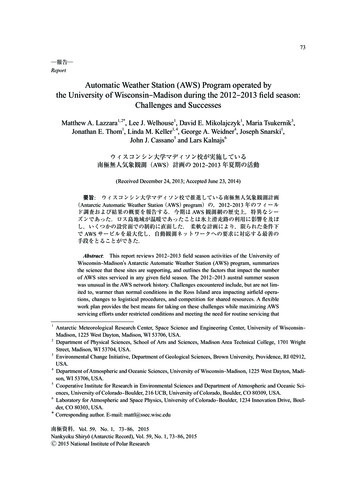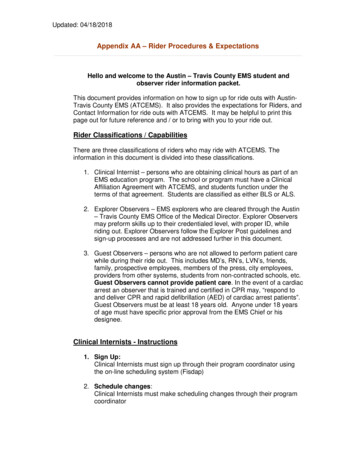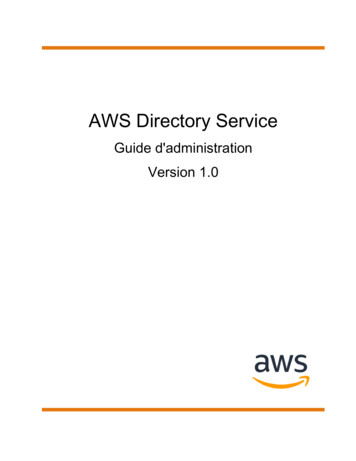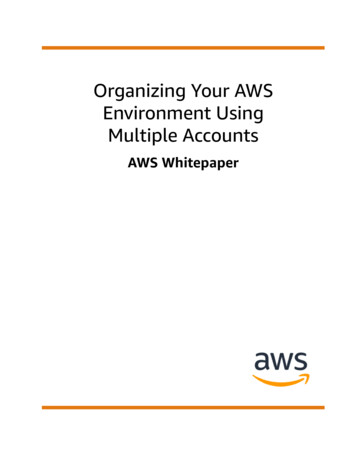
Transcription
Automatic Weather Station (AWS) Program 2012-2013 field season report73 報告 ReportAutomatic Weather Station (AWS) Program operated bythe University of Wisconsin-Madison during the 2012-2013 field season:Challenges and SuccessesMatthew A. Lazzara1, 2*, Lee J. Welhouse1, David E. Mikolajczyk1, Maria Tsukernik3,Jonathan E. Thom1, Linda M. Keller1, 4, George A. Weidner4, Joseph Snarski1,John J. Cassano5 and Lars �AWS)計画の 2012-2013 年夏期の活動(Received December 24, 2013; Accepted June 23, 2014)要旨: ntarctic Automatic Weather Station(AWS)program)の,2012-2013 �を報告する.今期は AWS �た. � AWS ��をとることができた.Abstract: This report reviews 2012-2013 field season activities of the University ofWisconsin-Madison's Antarctic Automatic Weather Station (AWS) program, summarizesthe science that these sites are supporting, and outlines the factors that impact the numberof AWS sites serviced in any given field season. The 2012-2013 austral summer seasonwas unusual in the AWS network history. Challenges encountered include, but are not limited to, warmer than normal conditions in the Ross Island area impacting airfield operations, changes to logistical procedures, and competition for shared resources. A flexiblework plan provides the best means for taking on these challenges while maximizing AWSservicing efforts under restricted conditions and meeting the need for routine servicing that1Antarctic Meteorological Research Center, Space Science and Engineering Center, University of WisconsinMadison, 1225 West Dayton, Madison, WI 53706, USA.2Department of Physical Sciences, School of Arts and Sciences, Madison Area Technical College, 1701 WrightStreet, Madison, WI 53704, USA.3Environmental Change Initiative, Department of Geological Sciences, Brown University, Providence, RI 02912,USA.4Department of Atmospheric and Oceanic Sciences, University of Wisconsin-Madison, 1225 West Dayton, Madison, WI 53706, USA.5Cooperative Institute for Research in Environmental Sciences and Department of Atmospheric and Oceanic Sciences, University of Colorado-Boulder, 216 UCB, University of Colorado, Boulder, CO 80309, USA.6Laboratory for Atmospheric and Space Physics, University of Colorado-Boulder, 1234 Innovation Drive, Boulder, CO 80303, USA.*Corresponding author. E-mail: mattl@ssec.wisc.edu南極資料,Vol. 59,No. 1,73-86,2015Nankyoku Shiryo (Antarctic Record), Vol. 59, No. 1, 73-86, 2015 2015 National Institute of Polar Research
M. Lazzara et al.74maintaining an autonomous observing network demands.1.IntroductionSurface meteorological and climatological observations in Antarctica require an autonomous platform, as there are very few year-round observing stations, and these are mostlyconstrained to the coastline. Since the 1980s, Automatic Weather Stations (AWS) havecarried out this task of observing meteorological conditions across the Antarctic. (e.g.,Allison et al., 1993; Lazzara et al., 2012; van den Broeke et al., 2004). Today, the international AWS network is the largest network on the continent (Figure 1). This report outlinesthe 2012-2013 field season to service and maintain the portion of the Antarctic AWS network managed by the University of Wisconsin-Madison with funding support from theUnited States' National Science Foundation (NSF). The Wisconsin AWS network includessegments managed directly by the University of Wisconsin. It also contains segments jointlyoverseen between the University and other nations including Japan, France, etc. The 20122013 field season saw several challenges not experienced previously (particularly in theprior seasons reported in Lazzara et al., 2013 and Mikolajczyk et al., 2013). This report reviews the field personnel, activities accomplished, challenges encountered, and offers someFig. 1.Map of all known Antarctic Automatic Weather Station (AWS) sites in 2013.
Automatic Weather Station (AWS) Program 2012-2013 field season report75concluding remarks on management of a large network in a physically challenging and logistically limited environment.2.2012-2013 Field Season Plans and ExpectationsThe original plans for the 2012-2013 field season called for visiting 11 sites in theRoss Island area, 6 sites on the Ross Ice shelf, 6 sites in West Antarctica, one on the Antarctic Peninsula, and one in East Antarctica for a total of 25 AWS site visits planned out of anetwork of 57 sites. Tasks planned included station repairs, operating system upgrades, andinstallation of a few new systems some with newer communication systems. This seasonincluded limited collaborations with international collaborators, primarily with the Institutpolaire français Paul-Emile Victor (IPEV) in Terre Adelie Land in East Antarctica. The2012-2013 field season did not include any planned collaborations with the Japanese Antarctic Research Expedition (JARE); however, in future field seasons (likely the 2014-2015season or beyond) joint field activities in that segment of the network are anticipated.During their traverse from Dumount D'Urville to Dome Concordia, IPEV visited/inspectedthe three AWS along the route. The only AWS that needed maintenance was D-10, whichwas raised.3.Field PersonnelFor the 2012-2013 field season, the field team consisted of Lee Welhouse, DavidMikolajczyk, and Joseph Snarski from the University of Wisconsin-Madison's AntarcticMeteorological Research Center (AMRC), Space Science Engineering Center (SSEC), andMaria Tsukernik from Environmental Change Initiative (ECI), Department of GeologicalSciences, Brown University. Lee Welhouse and David Mikolajczyk deployed to McMurdoStation on November 28, 2012 for the early portion of the season. David Mikolajczyk departed McMurdo Station on December 20, 2012. Maria Tsukernik arrived in McMurdo onDecember 30, 2012 to complete the final portion of the season along with Joseph Snarski,who arrived in McMurdo on January 3, 2013. Joseph departed on January 19 while Lee andMaria departed on February 9.4.Field ActivitiesThis field season focused on a series of tasks including the continued roll out of a veryhigh frequency (VHF) modem communications network in the Ross Island/McMurdo Station region. Servicing and repairing AWS systems is the number one activity planned formost field seasons, therefore 2012-2013 was not unique. Continuing this year was the replacement of older AWS equipment, which is an effort that has been underway for someyears. A primary goal was the removal of the older Campbell Scientific, Inc. (CSI) CR10Xbased equipment as they can run into time-keeping issues, making the data observationsmore difficult to use. This older hardware is no longer supported by CSI. The replacement/
M. Lazzara et al.76removal of all older Bendix/Belfort aerovanes was an additional priority, as refurbishmentof these systems is no longer practical. RM Young systems are in wider use across the network (Lazzara et al., 2012). Finally, the older Wisconsin AWS2B systems were removed,especially if any were near failure or have failed. A final effort underway, which extendsacross multiple field seasons, is to run a series of multi-year tests of Wisconsin AWS2B systems side-by-side with the newer AWS-CR1000 CSI based hybrid/custom systems. A mapof sites actually visited is shown in Figure 2.The move from the older AWS2B and unsupported CR10X based AWS to a custom/hybrid AWS-CR1000 CSI based system provides the benefits of both using existing, provenand reliable sensors while taking advantage of more modern equipment that reduces timefor design, assembly and testing. The newer AWS-CR1000 CSI systems enable the abilityto have more sensors (e.g., acoustic depth gauge to measure snow accumulation at the station, incoming solar radiation, etc.) than was possible on the AWS2B (Lazzara et al., 2012).Communication options are more diverse on the AWS-CR1000, where Argos, Iridium orVHF methods are all options. AWS2B was enabled to work as an Argos enabled deviceonly.Fig. 2.The UW-Madison AWS sites across the Antarctic, with those visited in the 2012-2013 field seasonhighlighted by yellow text boxes that indicate the AWS name.
Automatic Weather Station (AWS) Program 2012-2013 field season report5.77Science Objectives and Sites Visited5.1.Ross Island RegionThe AWS observing efforts in the Ross Island region are centered on several sciencefocal points. First, the stations round out a regional network used for operational forecasting.The Wisconsin AWS are the first-line observations of incoming weather events to strike thearea (See inset map B on Figure 1 and 2). Second, several of the AWS sites, including CapeBird, Windless Bight, Lorne, Minna Bluff and Marble Point II, are used as a part of a tropospheric ozone study project (Kalnajs et al., 2013; Seefeldt et al., 2013). Third, many of theAWS in this area have been installed and maintained for over 25 years, and some for morethan 30 years, allowing the observations to contribute to understanding the climatology ofthe region.A VHF system, using FreeWave Technologies equipment (and henceforth referred toas Freewave), to communicate the weather observations has been employed to relay theweather observations from the AWS sites within line-of-sight of a base reception station,which is ultimately McMurdo Station. Some of the AWS sites on the network are acting asa relay node. For example, Cape Bird AWS, which is not within line-of-sight of McMurdoStation, relays its data to Marble Point II AWS, which is within line-of-sight. This method,employing VHF radio frequencies of roughly 900 MHz, enables the data to be made available in real-time to weather forecasters for operational support decisions, while not requiring the reoccurring costs associated with satellite communications. The data are then relayedfrom McMurdo Station back to the University of Wisconsin-Madison via Internet using theFig. 3.White Island AWS with Mt. Erebus shown in the background.
M. Lazzara et al.78Table 1.Summary of 2012-2013 AWS field season activity.Antarctic-Internet Data Distribution (Antarctic-IDD) system using the Local Data Management (LDM) system (Lazzara and Antarctic-IDD collaborators, 2008; Seefeldt et al., 2009).In the Ross Island region, one new AWS was installed at White Island (78.08 S, 167.45 E) during the 2012-2013 season (Figure 3). This system is serving primarily as a relay forother AWS in the region on the new Freewave VHF communications network, as part ofevolving this one segment of the AWS network away from a satellite-based communicationsnetwork. A second visit was required to fix some minor issues with the power system. Athird visit attempted to fix a problem with the acoustic depth gauge sensor, although thatwas not successful. Ferrell AWS (77.82 S, 170.82 E) was visited, where both a WisconsinAWS2B system and a newer AWS-CR1000 system have been running side-by-side. Theolder AWS2B system was removed during the visit. An annual visit was required atWindless Bight AWS (77.73 S, 167.68 E) to raise the station due to the heavy snowaccumulation at this location. However, a raise could not be accomplished this year due tothe co-located ozone monitoring system installed. Accommodations for this will be arrangednext season. Meantime, a newer CR1000 Freewave VHF transmitter was installed at thesite. Minna Bluff AWS (78.56 S, 166.69 E) had its wind direction fail, and initial inspection
Automatic Weather Station (AWS) Program 2012-2013 field season report79was inconclusive as to the cause of the fault. Upon the arrival of a spare system at McMurdoStation, a second visit to Minna Bluff AWS was made to replace this sensor and fix theproblem.Lorne AWS (78.22 S, 170.02 E) was visited several times during the season. The initial visit could not be completed due to a laptop computer failure in the cold conditions. Toallow the work to be completed, the electronics were recovered from the site, and work wascompleted in the lab at McMurdo Station. A second visit re-installed the electronic system,along with a new Freewave VHF modem communications system. Transmission failuresprompted additional visits to optimize the relay of the observations from Lorne AWSthrough White Island AWS. These repairs were successful until White Island lost powerduring the winter-over period. Complications associated with a failure of transmissionsfrom a station acting as a relay (such as White Island) raises a question of reliability ofFreewave VHF communication. It is important to note that the newer AWS-CR1000 system,such as the Freewave network uses, are equipped with compact flash memory cards to logthe observations in an effort to prevent the loss of data during communications outages.Marble Point AWS (77.44 S, 163.75 E) was visited, primarily to check on the new MarblePoint II CR1000 system. Data was retrieved from the system, and an update was completedto the data logger operating system. Willie Field AWS (77.87 S, 166.95 E) was havingelectronic difficulties and was replaced as a result.5.2.Ross Ice ShelfThe AWS throughout the Ross Ice Shelf region are being primarily used to understandthe wind flow and dynamics including the Ross Ice Shelf air stream, corner jets, etc. (NigroFig. 4.Schwerdtfeger AWS as seen a) before servicing and b) after install of the newer equipment and sensors.
M. Lazzara et al.80Fig. 5.The raising of sensors is the most common activity required at many AWS sites as seen here, witha) Tall tower before the raise and b) Tall Tower after the raise with the entire station pictured.and Cassano, 2014; Nigro et al., 2012) and to characterize the climatology of the region(work currently in progress Costanza et al. in preparation). Weather forecasting is anotheruse of these observations, as they are utilized to monitor incoming weather systems thataffect both the McMurdo Station/nearby airfields and flight operations between theMcMurdo area toward other field camps in the region and toward South Pole Station. TheAWS network is the only routine weather observing system available in the Ross Ice Shelfregion.At Schwerdtfeger AWS (79.88 S, 170.11 E), the Wisconsin AWS2B was replaced witha CR1000-based AWS (Figure 4). Issues with the battery system were fixed while at thesite. A new instrumentation boom was installed at Marilyn AWS to improve issues with datatransmissions. Alexander Tall Tower! AWS* (79.04 S, 170.65 E) was visited to raise thelowest two sensor levels (Figure 5). Additionally, the communications system was upgradedto Iridium. Difficulties doing this on the first attempt, however, required a second visit tofix, which was not completely successful as the system data transmissions are incorrect. Thestation is collecting data, but not currently transmitting in real-time.5.3.West AntarcticaWith recent research on the significant climate changes seen in West Antarctica, theprincipal use of the AWS network in this region is to continue to capture observations tofurther understand the climate of the region and how it is continuing to change. In particular,warming on the order of 2.18 1.25 from 1958 to 2010 has been observed using a combination of staffed station and AWS temperature observations from Byrd Station and Byrd*The exclamation mark (!) is a part of the name of this AWS, included by the support staff who worked at themany attempts to install this AWS over two field seasons (2009-2010 and 2010-2011).
Automatic Weather Station (AWS) Program 2012-2013 field season report81AWS (Bromwich et al., 2013). The annual trend over this period is 0.42 0.24 and is statistically significant at the 99 % level. This ranks central West Antarctica as one of the rapidly warming sites on Earth. Some of the AWS in the region are also used for weather forecasting, as no other long-term, year-round observations exist for the region.Three stations were serviced this season. Janet AWS (77.17 S, 123.39 W) was raisedand a new power system installed to replace the failed system on site. A problem with acharge controller required a second visit to make the site fully operational. The AWS at theWest Antarctic Ice Sheet (WAIS) Divide field camp, known as Kominko-Slade (79.47 S,112.11 W), was visited to collect data recorded on a memory card as well as to upgrade theoperating system on the datalogger. Power and instrumentation issues at Erin AWS (84.90 S, 128.85 W) necessitated replacing the Wisconsin AWS2B with a CR1000-based AWS atthis site.5.4.East AntarcticaThe AWS network in East Antarctica between Dumont D'Urville Station and Concordia Station has been used in a variety of studies including katabatic wind events (e.g., Parishet al., 1993; Wendler et al., 1993), blowing snow studies (Gallée et al., 2012), and temperature studies (Genthon et al., 2011). These AWS are jointly managed by the UW-Madisonand IPEV. The interest in these sites, in addition to supporting science activities, includesgathering weather data for an alternative emergency landing site at D-85. As with manyAWS observations across the Antarctic, the observations are made available on the GTS forinsertion into real-time global numerical forecast models.A very limited set of work was planned for this portion of the continent in the 20122013 field season. The IPEV traverse from Cape Prudhomme, near Dumont D'Urville Station, to Concordia Station goes past several AWS sites. The traverse visited D-85 AWS(70.43 S, 134.15 E) and D-47 AWS (67.40 S, 138.73 E) sites, but they did not require anymaintenance. The D-10 AWS (66.71 S, 139.83 E) was visited and raised. Dome C II AWS(75.12 S, 123.37 E) was also briefly visited; however, no servicing work was accomplishedthis season.6.6.1.Challenges and SuccessesChallengesChallenges faced this season can be classified as those that were unexpected/unplanned, weather related, and programmatic constraints. Many of the revisits to some siteswere unplanned due to unexpected failure, while some revisits were originally planned dueto the complexity of maintenance efforts (such as to Alexander Tall Tower! AWS). Plannedvisits typically include routine maintenance, raising sensors to maintain a constant heightabove the snow surface, and established repairs. Unexpected visits are made to mitigate anyfailures to AWS sites that occur during the field season that can be fixed with the availablelogistics to visit the sites. Considering other complications affecting the 2012-2013, theseunplanned revisits had a small impact on the overall outcomes.Weather often impacts most field seasons, some more than others. This season PegasusNorth AWS (77.96 S, 166.52 E), located at the Pegasus Airfield, had the fifth warmest
M. Lazzara et al.82Table 2. Field season temperatures and statistics from Pegasus North AWS 1990-2012/2013 (a few years ofdata are missing from the record over the 23-year record due to occasional periods when the AWSwas not working).December, tied with December 1990, over a 23 year observing period (1990- 2012)followed by the sixth warmest January, tied with January 2002 (See Table 2). The meantemperatures were warmer than the long term running mean over the observing period inboth December (1.4 ) and January (0.7 ), when observations were available during theperiod. These warmer conditions combined with volcanic dust blown over the snow surfacescreated melted snow surface conditions that impacted logistical operations. We are currentlyinvestigating the meteorological significance of such a melt event in a follow up study. Thepoor runway conditions, combined with programmatic constraints (e.g., limited resourcesand logistics in the field), made it difficult to complete all of the fieldwork aimed for in theseason.6.2.Successes and Lessons LearnedDespite all of the challenges encountered,, this field season met a threshold of visiting50 % of planned AWS sites, a modest level of serviced and repaired AWS sites and one newAWS installed. Lessons learned included a reminder of the necessity of patience and flexibility in Antarctic fieldwork. Upcoming field seasons aiming for more definitive scheduling,will keep primary goals in mind, with secondary ones planned. Targeting a visit to at leastone AWS per region of the continent per field season for needed fieldwork allows at leastone AWS to be working to capture the climate of the region. Being able to maintain regionalmeasurements with at least one recently serviced and working AWS in the area can be important for filling any gaps in nearby AWS time series if failures occur (e.g., Reusch andAlley, 2004). From an operational standpoint, maintaining some AWS sites is crucial forproviding accurate weather forecasts. From a climatological standpoint, gaps in data recordscause significant difficulty in applying the data to various research problems. At specificAWS sites, maintaining AWS sensor heights above the snow surface is vital as well (Ma etal., 2011).7.7.1.AWS Data Availability and ApplicationsAWS Data AvailabilityObservations made by the AWS network are available via two temporal periods: realtime and archive. Real-time observations are made available via a series of methods. Observations are placed on the World Meteorological Organization's (WMO) Global Telecommu-
Automatic Weather Station (AWS) Program 2012-2013 field season report83nications System (GTS), as a subset of the network is designated as WMO stations. TheBritish Antarctic Survey places the remaining AWS observations on the GTS as synopticmobile messages. Real-time observations are decoded by the AMRC at the University ofWisconsin as well as on site at Palmer Station and McMurdo Station where direct broadcastfacilities and data streams are available. The data are then posted to the AMRC web site(http://amrc.ssec.wisc.edu/). The observations are displayed as text listings, time series meteorograms and plotted on maps. Other methods used to distribute the real-time observationsinclude the Abstract Data Distribution Environment (ADDE) data server, accessible by avariety of meteorological analysis software. Also, the data are relayed over the AntarcticIDD using the LDM software.Historical and official archived AWS data are available primarily from the AMRC filetransfer protocol (FTP) site (ftp://amrc.ssec.wisc.edu/pub/aws). The data are provided inquality controlled and raw formats. Raw observations are available with a temporal spacingof 10 minutes. Quality controlled observations are made available with a temporal spacingof 3 hours, and in most cases since 2010 in 1 hour and 10 minute time spacing. An e-mailinglist is used to notify the community of updates and changes to the archive collection. Anyone can subscribe to the mailing list found at the bottom of the AMRC Contact Us webpage (http://amrc.ssec.wisc.edu/contactus.html). Additional means for providing the archivequality AWS observation have been tested, including AMRC's repository for archiving,managing and accessing diverse data or RAMADDA server. Unfortunately at the time thispaper was submitted, this server system was not operational at the AMRC, but a version ofthis or something like this may be in the coming year. Plans include releasing an AWS observational data gateway to provide the community easy access to the AWS observationalcollection.7.2.Sample AWS ApplicationsThere is a range of applications for AWS observations among the community. Realtime weather forecasting is the number one operational use of the network. A variety of research utilizes observations from the network as well. In the past two years, approximately15 peer-reviewed papers and a PhD thesis were published on projects have used AWS observations. Projects employing AWS observations included remote sensing of melt (e.g.,Steiner and Tedesco, 2014) and validation of satellite observations (e.g., Das et al., 2014;Picard et al., 2013). Aspects of glaciological studies related to sediment transport and deposition utilized the AWS observations (Chewings et al., 2014). Wind systems were a focus ofsome papers including those in the McMurdo Dry Valleys (Speirs et al., 2013), and strongwind events at McMurdo Station (Chenoli et al., 2013). Boundary layer studies, with somecentered on Dome C Antarctica (Champollion et al., 2013; Macelloni et al., 2013; Pietroniet al., 2014) and some in Adelie Land (Preunkert, et al., 2013), make use of the AWS. Otherboundary layer studies using both AWS and unmanned aerial vehicles have also been published (Cassano, 2013). AWS observations have been used to gauge numerical model performance (Bromwich et al., 2013). Other publications included studies of the synoptic climatology of the Ross Ice Shelf and Ross Sea regions (Coggins et al., 2013); the impact ofsynoptic scale features on warming and precipitation at Dome Fuji Station (Hirasawa et al.,2013); and the synoptic variability of the Ross Sea region (Cohen, 2013; Cohen et al.,2013).
M. Lazzara et al.848.Summary and Concluding RemarksOne of the unique aspects of maintaining the AWS observational network is thenecessity of fieldwork. A full time job in and of itself, keeping a network of 50 to 70 AWSsystems operating even with international partners, requires a devoted effort of AWS fabrication and assembly team members doubling as repair and field personnel. Flying to remoteplaces around the Antarctic continent and dealing with polar weather conditions makesmaintenance a challenge. In summary, a partial season is counted as a successful season inAntarctica. Flexibility is key. One of the biggest needs for the AWS network is attemptingto have a routine service and maintenance schedule. This is taken for granted at many midlatitude automated weather stations, but very difficult to accomplish in remote locationssuch as the Antarctic continent. The two prior seasons were very successful efforts. In2011-2012, goals of servicing were nearly fulfilled, with 21 of 25 planned sites visited/serviced. The season prior, 2010-2011, had a phenomenal success rate making all 27planned AWS site visits (Lazzara et al., 2013). The 2012-2013 field season contrasts withonly 15 of 25 sites visited due to weather and logistics. As indicated by the last three fieldseasons, not every field season can be as successful as the last, and planning for unexpectedcomplications is important as we look forward to 2013-2014 field season.AcknowledgmentsThe authors wish to thank those who have supported the AWS program in the field, andspecifically to Ken Borek Air, the 109th New York Air National Guard, PHI Helicopters,Antarctic Support Contract/Lockheed Martin, our international partners in France, Australia,United Kingdom, Japan, New Zealand, and especially the Division of Polar Programs,Geoscience Directorate at the National Science Foundation in the USA. Special thanks toLiz Kauffman, and John Rand of Antarctic Support Contract/Lockheed Martin for their helpand support. This material is based upon work support by the National Science FoundationGrant Nos. ANT-0944018, ANT-0943952, ANT-1043266, ANT-1043478, and ANT-1245663.ReferencesAllison, I., Wendler, G. and Radok, U. (1993): Climatology of the East Antarctic ice sheet (100 E to 140 E)derived from automatic weather stations. J. Geophys. Res., 98, 8815-8823, doi:10.1029/93JD00104.Bromwich, D.H., Otieno, F.O., Hines, K.M., Manning K.W. and Shilo, E. (2013): Comprehensive evaluation ofpolar weather research and forecasting model performance in the Antarctic. J. Geophys. Res. Atmos., 118,274-292, doi:10.1029/2012JD018139.Cassano, J.J., (2013): Observations of atmospheric boundary layer temperature profiles with a small unmannedaerial vehicle. Antarctic Science, 26, 205-213, doi:10.1017/S0954102013000539.Champollion, N., Picard, G., Arnaud, L., Lefebvre, E. and Fily M. (2013): Hoar crystal development anddisappearance at Dome C, Antarctica: observation by near-infrared photography and passive microwavesatellite. The Cryosphere, 7, 1247-1262, doi:10.5194/tc-7-1247-2013.Chenoli, S.N., Turner, J. and Samah, A.A. (2013): A climatology of strong wind events at McMurdo station,Antarctica. Int. J. Climatol., 33, 2667-2681, doi:10.1002/joc.3617.Chewings, J.M., Atkins, C.B., Dunbar, G.B. and Golledge, N.R. (2014): Aeolian sediment transport and depositionin a modern high-latitude glacial marine environment. Sedimentology, 61, 1535-1557, doi:10.1111/sed.12108.Coggins, J.H.J., McDonald, A.J. and Jolly, B. (2013): Synoptic climatology of the Ross Ice Shelf and Ross Sea
Automatic Weather Station (AWS) Program 2012-2013 field season report85region of Antarctica: k-means clustering and validation. Int. J. Climatol., 34, 2330-2348, doi:10.1002/joc.3842.Cohen, L. (2013): Atmospheric variability and precipitation in the Ross Sea region, Antarctica. Victoria Universityof Wellington, Ph.D. thesis.Cohen, L., Dean, S. and Renwick, J. (2013): Synoptic weather types for the Ross Sea region, Antarctica. J.Climate, 26, 636-649, doi:10.1175/JCLI-D-11-00690.1.Das, N.N., Chan, S.K., Njoku, E.G. and Li, L. (2014): Intercomparisons of brightness temperature observationsover land from AMSR-E and WindSat. IEEE Transactions on Geoscience and Remote Sensing, 52, 452-464,doi:10.1109/TGRS.2013.2241445.Gallée, H., Trouvilliez, A., Agosta, C., Genthon, C., Favier, V. and Naaim-Bouvet, F. (2012): Transport of snow bythe wind: A comparison between observations in Adélie Land, Antarctica, and simulations made with theregional climate model MAR. Boundary-Layer Meteorol., 146, 133-147, doi:10.1007/s10546-012-9764-z.Genthon, C., Six, D., Favier, V., Lazzara, M. and Keller, L. (2011): Atmospheric temperature measurement biaseson the Antarctic Plateau. J. Atmos. Oceanic Technol., 28, 1598-1605, doi:10.1175/JTECH-D-11-00095.1.Hirasawa, N., Nakamura, H., Motoyama, H., Hayashi, M. and Yamanouchi, T. (2013): The role of synoptic-scalefeatures and advection in prolonged warming and generation of different forms of precipitation at Dome Fujistation, Antarctica, following a
1 Antarctic Meteorological Research Center, Space Science and Engineering Center, University of Wisconsin - Madison, 1225 West Dayton, Madison, WI 53706, USA. 2 Department of Physical Sciences, School of Arts and Sciences, Madison Area Technical College, 1701 Wright Street, Madison, WI 53704, USA.










![[AWS Black Belt Online Seminar] AWS X-Ray](/img/17/20200526-blackbelt-x-ray.jpg)
